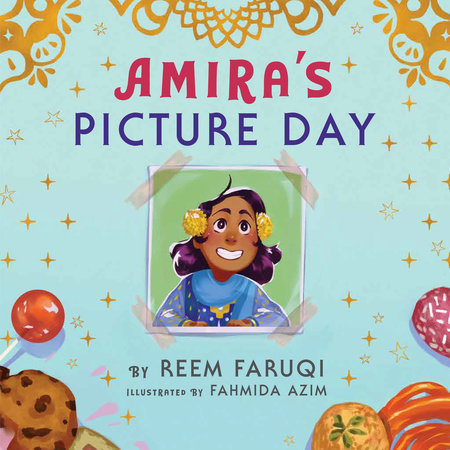This review was originally published in School Library Journal in March, 2021. Additional illustrations and an activity have been added to this post.
Amira’s Picture Day
 K-Gr 2–Amira feels conflicted when she realizes that school picture day is the same day as Eid. Spotting the crescent moon marking the end of Ramadan, Amira and her brother Ziyad know it means that there will be prayers, celebrations, and skipping school the following day. Amira’s mom decorates the girl’s hands with mehndi. Amira and Ziyad prepare goody bags for the kids at the masjid, while her mother irons Amira’s Eid outfit, a beautiful blue and gold mirrored shalwar kameez.
K-Gr 2–Amira feels conflicted when she realizes that school picture day is the same day as Eid. Spotting the crescent moon marking the end of Ramadan, Amira and her brother Ziyad know it means that there will be prayers, celebrations, and skipping school the following day. Amira’s mom decorates the girl’s hands with mehndi. Amira and Ziyad prepare goody bags for the kids at the masjid, while her mother irons Amira’s Eid outfit, a beautiful blue and gold mirrored shalwar kameez.  Though Eid is full of the joy and community she loves, missing picture day puts a damper on the celebration, until Amira thinks of a possible solution. Deceptively simple, Faruqi’s narrative gently addresses the impact that the celebration of non-dominant cultures and holidays has on children and choices families make to uphold traditions. Moreover, Amira’s conflicted feelings and insistence on finding a solution create opportunities for dialogue about the importance of acknowledging spaces that matter to children, especially while families try to foster positive identity. Azim’s illustrations are fun and colorful, with tiny details reflecting the family’s personality, while the people attending Eid celebrations at Amira’s masjid are racially and culturally diverse, with varied skin tones, body types, and expressions of fashion and style.
Though Eid is full of the joy and community she loves, missing picture day puts a damper on the celebration, until Amira thinks of a possible solution. Deceptively simple, Faruqi’s narrative gently addresses the impact that the celebration of non-dominant cultures and holidays has on children and choices families make to uphold traditions. Moreover, Amira’s conflicted feelings and insistence on finding a solution create opportunities for dialogue about the importance of acknowledging spaces that matter to children, especially while families try to foster positive identity. Azim’s illustrations are fun and colorful, with tiny details reflecting the family’s personality, while the people attending Eid celebrations at Amira’s masjid are racially and culturally diverse, with varied skin tones, body types, and expressions of fashion and style.
 Back matter features an author’s note and glossary of terms, referencing Urdu and Amira and her family’s Pakistani roots.
Back matter features an author’s note and glossary of terms, referencing Urdu and Amira and her family’s Pakistani roots.
VERDICT A lovely addition to the collection of books about Eid that can be used all year long.
Extended Activity & Lesson
As stated in the review above Amira’s Picture Day is an opportunity to talk to elementary students about identity and how holidays reflect identity and values. It is also an opportunity to talk about equity in holiday recognition, school calendars, and what it means to matter in all the spaces we are.
Here are some suggested questions to ask students while reading this book:
- How do you think Amira feels about missing picture day? Have you ever had to choose between two things that are important to you?
- Do you think Amira’s parents understand how she feels at first? Is Eid or picture day more important to Amira’s parents?
- How do you know that Amira’s parents want the children to be involved in the community?
- What is Amira’s masjid like? Does everyone look similar in body shape, skin tone, or dress or are they different? What do you observe about Amira’s Muslim community?
- How do you think Amira feels when she is at school wearing her shalwar kameez? How do you think she might feel about her friends seeing her in her shalwar kameez instead of her pink dress?
Pair this book with these videos about recognizing holidays.
- Newscasts: Henrico County/ Eden Prairie
- Secret Life of Muslims: Muslim Holidays Get Recognized in New York City
Questions:
- For the people in the videos what does it means to have their holiday recognized by their schools?
- What would it mean to have no holidays recognized? If winter and spring breaks stayed the same, what would it mean for holidays like Christmas or Easter? Is not recognizing any holidays but still keeping the same breaks really being fair to everyone?
- Have you ever had to go to school on a holiday that was important to you? How do you think it would feel to have to go to school on a holidays that was really important to you or your family?
- How do you think it would feel to have to choose between a holidays that is important to you and a big test that would impact your next school year?
- How did Linda’s daughter feel about seeing her holidays on the school calendar? What does it mean to have schools recognize your holidays?
- How does it feel to have schools recognize your identity, culture, and history?

 Amira’s Picture Day by Reem Faruqi
Amira’s Picture Day by Reem Faruqi